Potatoes are a favorite in the vegetable garden because they are fairly easy to grow, but that is not to say they do not have their issues, they do! As a home gardener, witnessing your potato plants wilting, yellowing, or dying can be disheartening and frustrating.
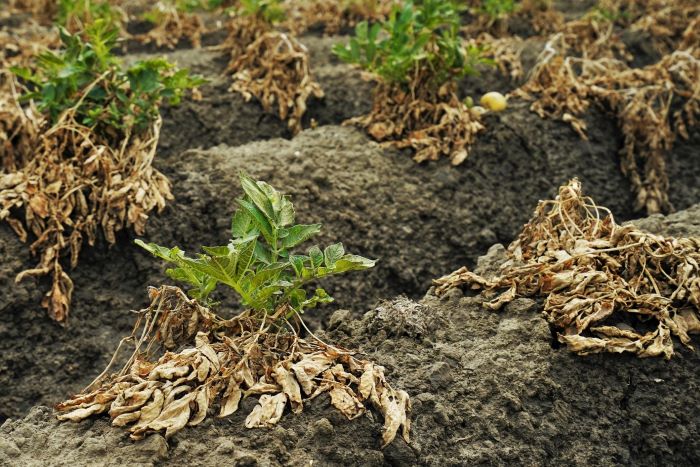
Related: How To Grow Potatoes in a Bag | Potato Leaf Pests | Can You Grow Sprouted Potatoes?
Table of Contents
Why Are My Potato Plants Dying?
The most likely reasons your potato plants are dying are watering issues, over-fertilization, a lack of nutrients, soil conditions, extreme temperatures, certain diseases, and pests, or they are ready to be harvested.
Read on to learn more about why your potato plants are dying, and how to fix it!
1. Watering Issues
One of the most common causes of dying potato plants is watering issues. If your plants get too much or too little water, they can begin to die.
Overwatering
If your potato plants are dying due to being overwatered the first sign is that the leaves of your plant will start to turn yellow, and begin to wilt. These are symptoms that your potato plant is suffering from root rot.
This disease occurs when the soil is too saturated, and causes the roots of your plant to rot, turning them into black mush. If your plant is suffering from root rot due to overwatering, it will be unable to get the water and nutrients it needs from the soil. A lack of nutrients and water will eventually kill your plant.
How to Fix it: To fix overwatering, the soil around your potato plants needs to dry out. This means you will need to stop watering your plants until the soil is mostly dry. The soil can be slightly damp, but not waterlogged.
The soil should take 2-3 days to dry out if the temperature is warm. Additionally, if you have mulch around your plants, remove it to speed up the drying-out process.
Underwatering
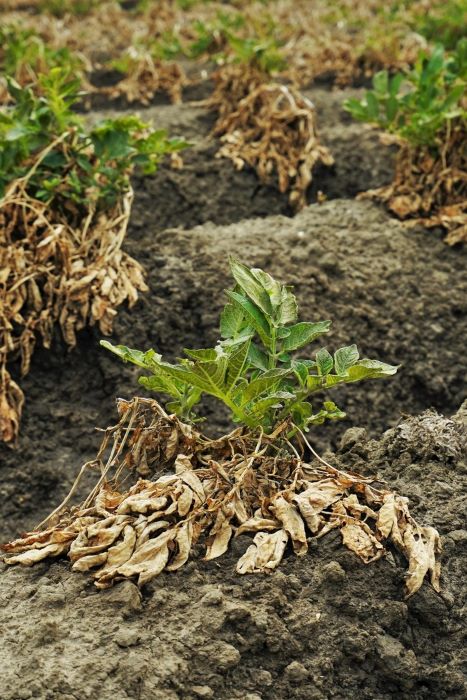
Like overwatering, underwatering can cause your potato plants to die. Underwatering your potato plants causes dehydration, the symptoms of which are curled leaves. If your potato plants are showing signs of dehydration above ground, they are most certainly showing signs below.
Potatoes that have been underwatered begin to crack and will be underdeveloped.
How to Fix it: The first thing you need to do is establish a proper watering schedule for your potatoes. Depending on your climate and natural rainfall, potatoes need watering every 2-3 days for a total of 1-2 inches of water over the course of a week. Before leaves have broken the surface, watering should only need to be done once a week (if that) which will help prevent them from getting waterlogged and rotting. Make sure you water below the leaves if possible, as wet leaves can lead to fungal infections. I water my potatoes in the early morning to make sure the leaves are dry by mid-day.
2. Over-Fertilization
Another reason your potato plants are dying could be caused by over-fertilization. Fertilizing potatoes can be tricky to get right because they are a hungry crop and need frequent fertilization, which can lead to over-fertilization.
Excessive nitrogen, in particular, causes your potato plants to grow tall, so tall in fact, that they begin to fall over and die. Additionally, your yield will not be as large, as your potato plant has put all of its efforts into producing lush, green foliage above ground.
Excessive fertilization of your potato plants can lead to fertilizer burn, which is when the roots of your plant get burnt and hinder the plant’s ability to take in nutrients. The leaves of your plant will begin to turn yellow and look burnt.
How to Fix it: If you have overfed your potatoes, the first thing you need to do is stop applying fertilizer to your plants. Next, remove any visible, excess fertilizer from the soil. Once you have done that you will need to flush the soil, which means heavily watering the area. Again, this should be done in the early morning so that the soil has sufficient time to dry out.
So, when should you fertilize your potatoes? The fertilization of your plants depends on your soil conditions, which we will cover below. But, as a general rule, your plants should be fertilized using nitrogen, and a calcium-rich fertilizer 4 weeks after planting. They should be fertilized again 2 weeks after that. I like this organic fertilizer here.
3. Soil Conditions
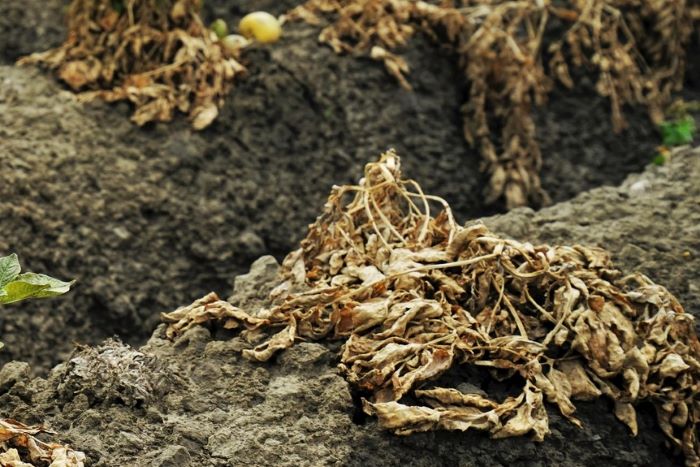
Soil conditions play a big role in maintaining your potato plant’s health. If the soil conditions are not correct, your potato plants will be unable to get the nutrients they need to thrive, and will eventually die.
If your potato plants are dying due to incorrect soil conditions, they will exhibit symptoms of nutrient deficiency. If this is the case, the leaves of your potato plants will start to turn yellow or brown, begin to wilt, shrivel up and die.
The potatoes themselves will show signs of a nutrient deficiency too, with potatoes turning brown on the inside, or cracking. Of course, you may only see this if you dig them up!
The type of soil your potatoes are planted in plays a big role in the nutrient levels and nutrient uptake. Potatoes prefer sandy soil that is well-draining, with an ideal pH level of between 6-6.5 with a range between 5.5-7 also being acceptable. The pH level is important because it reflects the amount of nutrients available to your plants.
If the pH balance is off, your potato plants will not get the correct amount of nutrients.
How to Fix it: First things first, you need to test your soil, which you can do using a home soil testing kit. If your soil is too acidic you can add limestone, whereas if your soil is too alkaline, you can add acidifier (sulfur). I also find that seasonal additions of homemade compost and aged manure go a long way to creating healthy fertile soil that potato plants will love. By looking after your soil, you will create the right environment for your plants to really thrive.
4. Extreme Temperatures
There are very few plants that can cope with extreme temperatures, and potatoes are definitely not one of them. Both extreme heat and cold can kill your potato plants.
Extreme Heat
If temperatures suddenly reach higher than 80 degrees Fahrenheit, your potato plants will begin to experience heat stress. Signs that your potato plants are experiencing heat stress include leaf rolling, which is when the leaves begin to curl into themselves. Another sign of heat stress is leaves that have turned light green that begin to wilt. They will eventually shrivel and die.
How to Fix it: If your potatoes are showing signs of heat stress, the first thing to do is cover them with shade until the temperature returns to normal.
Next, you will need to check the moisture level of your soil more frequently and increase watering based on this. I check my soil once a day during a heat wave and adjust my watering accordingly. If the soil is dry when you push your finger into it, it will need to be watered.
Another option to help your potato plants to fight the effects of heat stress is to apply calcium. This mineral helps your plants to cope better in temperatures that exceed 80 degrees Fahrenheit.
Extreme Cold
Potatoes will thrive in temperatures ranging between 65 and 80 degrees Fahrenheit. They can, however, tolerate temperatures as low as 32 degrees Fahrenheit, but anything below this will start to cause a problem.
If your potato plants have been exposed to cold temperatures, the leaves of your plant may begin to start turning black. In extreme cases, the entire plant above the ground will die.
How to Fix it: If the temperature drops, you can protect your potato plants by using a frost cover. Make sure it covers the entire plant. If all of the foliage above the ground has died, do not be too alarmed, as new shoots should appear within 14 days!
5. Diseases
Potato plants are susceptible to several diseases, the most harmful of which are early blight, late blight, verticillium wilt, and mosaic virus.
Early Blight
Early blight is a fungal disease that affects the leaves and stems of your potato plant. In severe cases that disease can cause all of your potato plant’s leaves to drop off, and can infect the potatoes below ground.
If early blight is the cause of your dying potato plants, you will notice brown spots encircled with yellow rings on the lower, older leaves. If the infection is severe enough it can infect the potatoes themselves, causing lesions to develop.
It is most likely to appear after a period of rain, or it can be spread through the use of infected compost.
How to Fix it: To treat early blight, you can use a copper fungicide spray which should be applied weekly. If the infection is bad, you will have to remove your potato plants and dispose of them properly. Make sure you sanitize your gardening equipment to avoid further outbreaks on other members of the nightshade family growing in your garden.
Late Blight
Late blight, like early blight, is a fungal disease that first presents with dark brown spots on the leaves and the stems of your plants. The disease attacks your potatoes making them inedible. It is spread through the wind and usually appears when temperatures are low.
How to Fix it: Sadly, there is no cure for late blight, so if your plants have been infected with the fungus, you will have to remove them. Prevention is the best cure in this case, so if you are worried about late blight in your garden, you can apply copper fungicide to your plants. Fungicide is a preventative measure, not a cure.
Verticillium Wilt
Verticillium wilt is a fungal disease caused by the Verticillium dahliae fungus, which lives in soil and appears in warmer, damp conditions, and is spread by the wind.
This disease could be behind your dying potato plants, especially if your area has recently experienced warmer, wet weather followed by drought. Symptoms to watch out for include the yellowing and wilting of your potato plant’s lower leaves. The entire plant will turn yellow, and result in the early death of your potato plant.
How to Fix it: Once your potato plants have been infected with verticillium wilt, there is nothing you can do to fix it. You will have to remove the infected plants and destroy them. The fungus lives in the soil and will continue to do so even after the plants have been removed. You can kill the fungus through solarization.
Solarization is when you heat the soil by focusing the sun’s heat through the use of a plastic tarp. You will need to keep the tarp over the soil for 5 weeks for the method to be effective.
Be sure to plant disease resistant potato varieties to help stop the spread of this disease.
Mosaic Virus
Mosaic virus is a general term given to three different potato viruses that devastate potato crops. They are viral diseases that spread through aphids, gardening tools, and irrigation, and are very common.
Symptoms vary depending on which strain of the virus your potato plant has, but generally, an infected plant will first present with a mosaic pattern on the leaves. The leaves of your potato plant will then turn brown. Another symptom is yellow mottling of the leaves and black, necrotic veins on the underside of the leaves.
How to Fix it: The awful thing about mosaic virus, is that there is no cure. Once your potato plants have been infected with the virus, you will need to remove and destroy them. You may be able to prevent the disease by covering your potato plants with floating row covers to stop aphid infestations, and by practicing good garden hygiene.
6. Pests
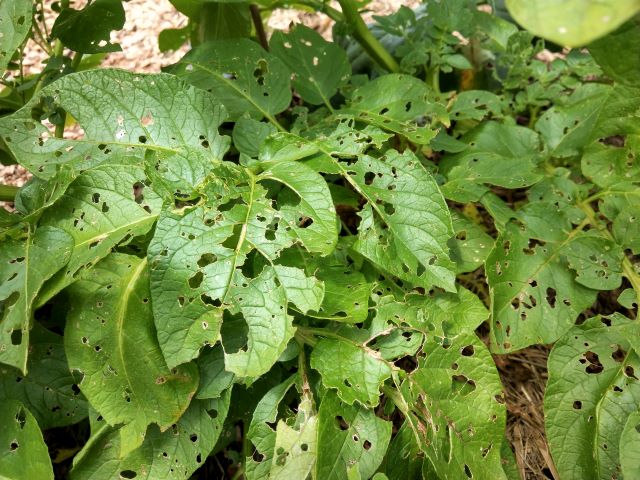
Potatoes, like any other plant in your garden, can fall victim to the feeding habits of hungry pests. From voracious beetles to stealthy underground larvae, these intruders can wreak havoc on your potato crop, jeopardizing your hard work and harvest.
The most destructive pests that can attack your potato plants are potato bugs, cutworms and flea beetles.
Colorado Potato Beetles also known as Potato Bugs
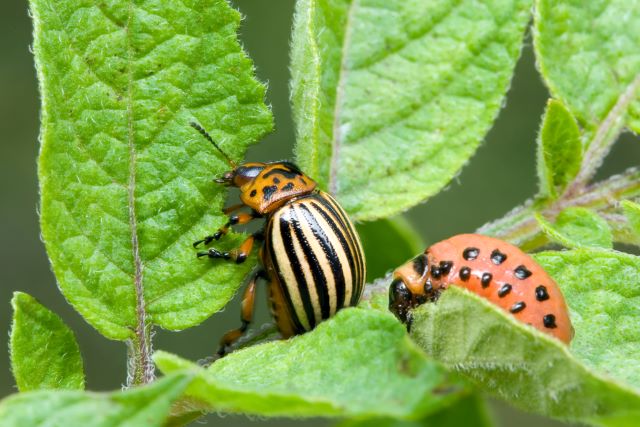
Colorado Potato Beetles (Leptinotarsa decemlineata) pose a significant threat to potato plants. They are notorious pests that feed on the leaves of potato plants.
The adult beetles as well as their larvae feed on the potato plant foliage, devouring the leaves and defoliating the plant if left unchecked. This defoliation can severely weaken potato plants by stunting growth, reducing yields, and even causing plant death.
Telltale signs of potato bugs are holes in your potato leaves. Organic and natural control of potato bugs includes hand removing the bugs, using neem oil on the plants to stop eggs from being laid on the leaves, and diatomaceous earth sprinkled on the ground.
We have a full article on identifying and controlling potato bugs using organic gardening methods.
Cutworms
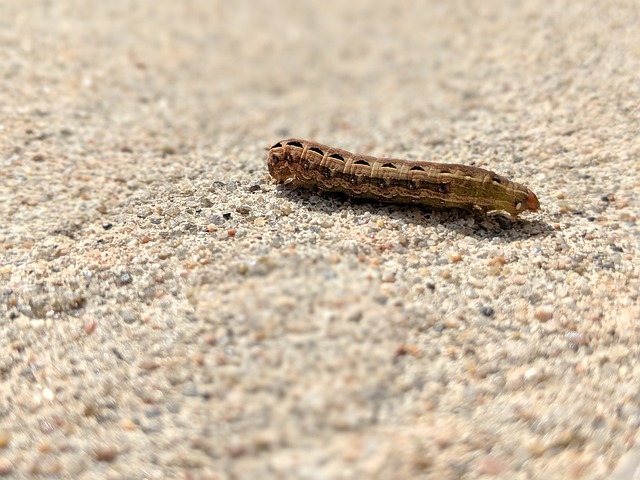
Cutworms are the larvae of various moth species that cut through the stems of plants near ground level. They are usually gray, black, brown, or pink and attack your plants at night.
As cutworms feed on the stems of your potato plants, they will begin to wilt. Willing and feeding damage to the foliage of your plants could be a sign of cutworms.
How to Fix it: Cutworms can be removed by hand at night while they munch on your plants. Once you have removed any visible caterpillars from your plants, spread diatomaceous earth on the ground.
Flea Beetles
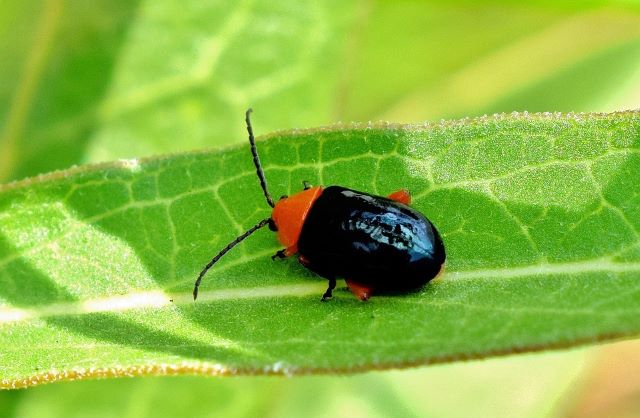
Flea beetles are small, darkly colored, jumping beetles whose feeding habits leave behind characteristic small holes in the leaves of your plants, known as shothole. Flea beetles can stunt the growth of your plants, and eventually kill them.
How to Fix it: If flea beetles are damaging your potato plants, a weekly application of neem oil should do the trick to repel them. Another way to stop flea beetles from attacking your potatoes is to spread diatomaceous earth around your plants.
7. Ready for Harvest
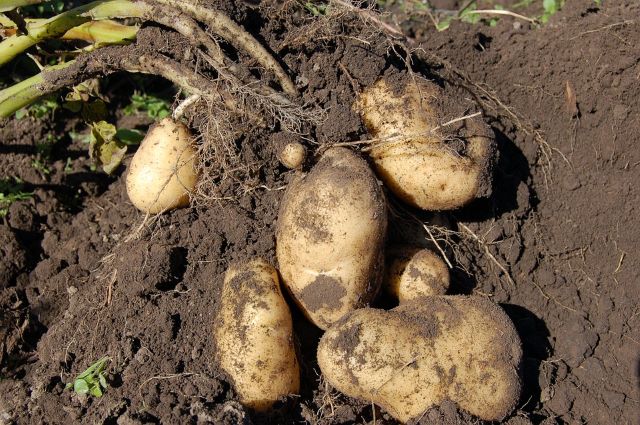
The final reason your potato plants could be dying is because they are ready to be harvested! Potato plants turn yellow, wilt, fall over, and die when they have reached maturity, signaling that your potatoes are ready to be dug up.
To know for certain that the reason your potato plants are dying is because they have reached maturity, you’ll need to keep track of when you planted them. The time from planting to maturity is dependent on the variety of potatoes you planted, but it is usually within the range of 80-120 days.
Further Reading:
